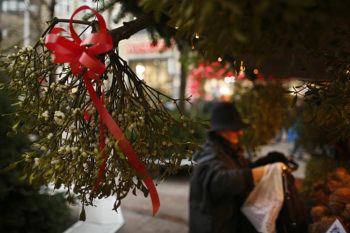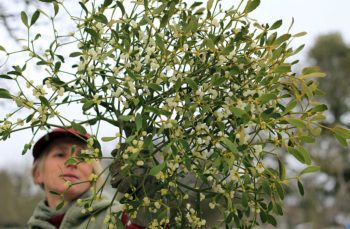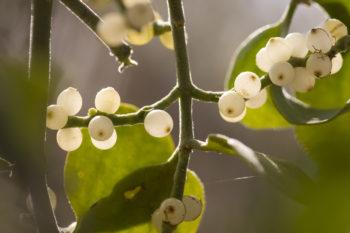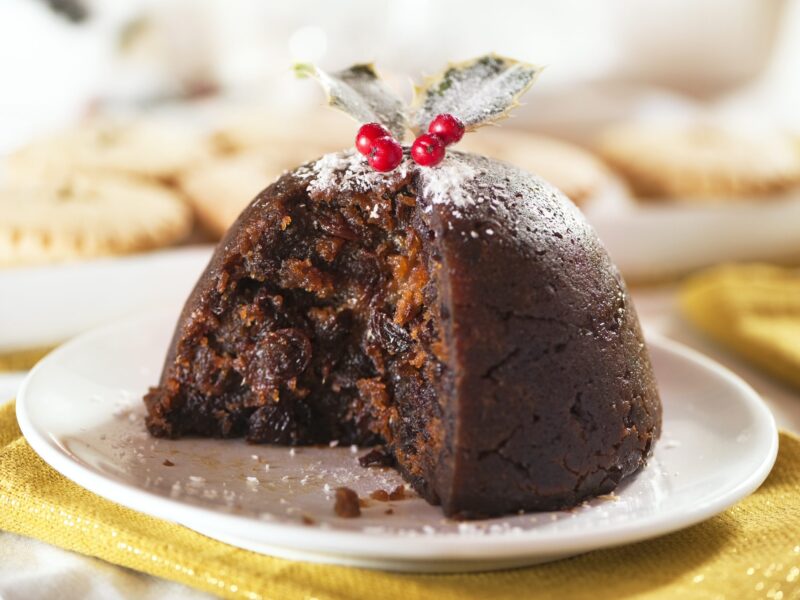Despite Its Romantic Reputation, Mistletoe Is A Nutrient-Stealing Parasite

Mistletoe may be a welcome holiday sight when hung over a doorway if a loved one is near. But it can be an unwelcome intruder when found in your trees, according to a Texas A&M AgriLife Extension Service horticulturist.
“Mistletoe is a hemiparasite – a semi-parasitic plant,” said Allison Watkins, AgriLife Extension horticulturist for Tom Green County. “It makes its food from photosynthesis, but the roots grow into the host tree, sucking water and minerals out from the sap.”
In other words, you likely do not want to see mistletoe growing on your favorite shade tree or prized ornamental. However, mistletoe can survive as long as the tree it inhabits. So, some mistletoe alive today may still be around in 100 years.
One type of mistletoe you commonly see used as decoration over the holidays is in the family Phoradendron, which appropriately translates to “thief of the tree” in Greek. Mistletoe has been used across various cultures throughout history for everything from warding off demons from entering a doorway to protecting babies from being stolen from their cribs in the night by fairies.
Although mistletoe is called the kissing plant, its name may have originated from Old English for the words for twig and dung. How’s that to get you in the romantic holiday spirit?
The Issues With Mistletoe
Mistletoe causes tree stress and can make a tree more susceptible to diseases and insects, Watkins said. Although unlikely to kill a healthy tree, it can cause limbs to die. It can be especially hard on a tree during drought.
Mistletoe easily spreads as birds eat the berries and then spread the seed from limb to limb and tree to tree through their feces. The seeds are exceptionally sticky and may also hitchhike on their feet and beaks.
Certain species of mistletoe can also shoot out their own seeds at speeds around 60 mph once the berry bursts like an overfilled water balloon.
Some mistletoe is poisonous, so it is always wise to use care when handling the plant. Different parts of the plant and different species have varying levels of toxicity. And while birds and wildlife eat the berries, it isn’t something you want your family members, including pets, to ingest.

How To Identify Mistletoe In Nature
Mistletoe is most easily spotted in winter when many of the host trees lose their leaves to reveal clusters of the evergreen mistletoe. The spherical shape can be as large as several feet across.
Since birds like to perch in the tops of high trees, mistletoe is most often found in mature trees near the crown. A tree branch may be enlarged where the plant has attached itself.
In Texas, the type of mistletoe you’ll find on trees typically has white berries in clusters. Although we mostly find mistletoe in our region on deciduous trees, like oak and mesquite, the plant’s 1,000-plus species around the world have adapted to survive on everything from cacti to pines.
A Friend To Forests, Pollinators And Woodland Creatures
Mistletoe plays a key role in many woodland and range ecosystems. For example, its white flowers provide nectar and pollen for native bees and honeybees. There are also several types of butterflies and moths that rely solely on mistletoe species as host plants for their caterpillars.
“Birds aren’t the only animals that munch on mistletoe – squirrels will also eat the berries, and deer and porcupines will eat the plant itself, especially if other food is scarce,” said Maureen Frank, Ph.D., AgriLife Extension wildlife specialist, Uvalde.
Many animals nest in clumps of mistletoe, especially when the plant causes its host tree to form witches’ brooms, which are dense masses of distorted branches, Frank said. Mistletoe and the corresponding witches’ brooms are used for shelter by tree squirrels, flying squirrels and a variety of birds, from tiny chickadees to raptors like Cooper’s hawks.
The damage done to trees by mistletoe can also provide homes for cavity-nesting species of birds, bats, insects and small mammals.

Should You Remove Your Mistletoe?
“Even if you remove mistletoe from a tree, the root-like structure remains embedded in the tree, meaning it will grow back,” Watkins said.
Although no herbicide can kill mistletoe without harming the tree, one plant growth regulator called ethephon, Florel Fruit Eliminator, is registered in the U.S. to control the growth of mistletoe on deciduous trees, she said.
The only way to eliminate mistletoe from a tree is to prune the branch it is on. If you feel like your tree is becoming overwhelmed with the parasite, keep in mind that mistletoe takes two to three years to mature so the sooner you can remove the infected branch, then the better you minimize spread. And the smaller the branch that must be removed, then the less stress on the tree.
“In most well-maintained landscapes, there may be mistletoe here or there but it’s probably not something to worry about too much,” Watkins said.
The stress from over-pruning could be more damaging than the mistletoe itself, she said. Watkins said to keep these tips in mind if you do decide to prune:
- Light pruning can be done any time of the year, but more significant pruning is best done in the winter when the tree is dormant.
- Prune no more than one-third of a tree’s canopy.
- Dead branches can be removed at any time.
- To avoid spreading oak wilt, oak trees should not be pruned from February to June. December and January are the ideal time to prune oaks.
- Paint the cuts to protect the tree.
For more information on mistletoe, visit Forest Health: Mistletoe by Texas A&M Forest Service.
This article by Susan Himes originally appeared on AgriLife Today.





